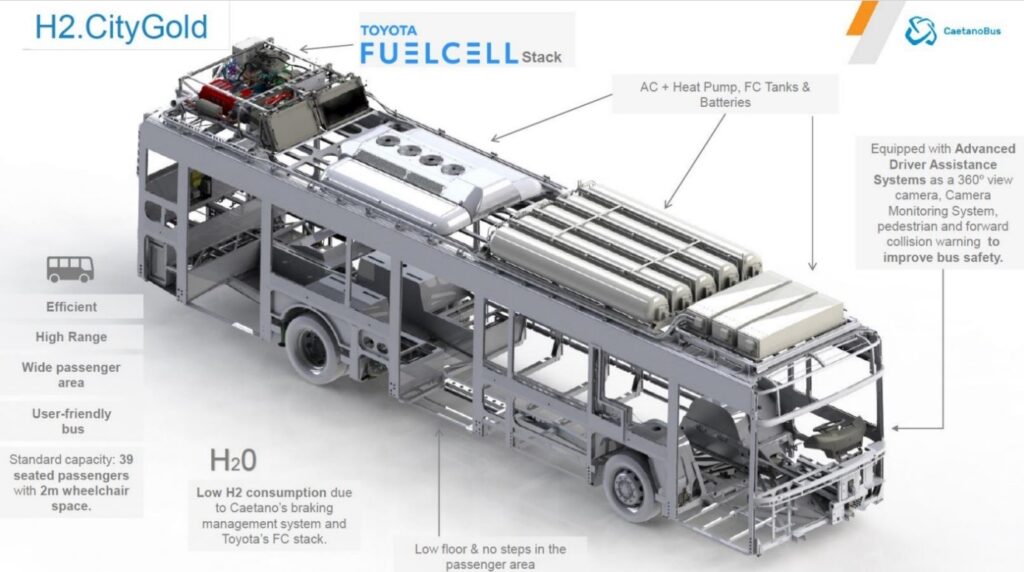In the face of an increasingly urgent need to reduce greenhouse gas emissions and combat climate change, the transportation industry is seeking more environmentally friendly solutions. One of the most promising directions for development is a bus powered by hydrogen fuel cells. Experts estimate that in a 12-year life cycle, a hydrogen bus saves up to 800 tons of CO₂ emissions compared to a diesel vehicle.
These buses utilize fuel cell technology to convert hydrogen and oxygen into electrical energy, which powers the vehicle. This process does not generate exhaust emissions, with the only by-product being pure water, making hydrogen fuel cell-powered buses one of the most environmentally friendly vehicles on the roads.
 Source: https://caetanobus.pt/en/home-3/
Source: https://caetanobus.pt/en/home-3/
There are several key advantages of buses powered by hydrogen fuel cells. Firstly, they are virtually silent compared to traditional diesel buses, contributing to reduced noise in cities and improved quality of life for residents. Secondly, they have a comparable range to conventional buses, meaning they can handle long routes without the need for frequent recharging. A key advantage of hydrogen buses is their short refueling time, averaging around 15 minutes. Charging times for battery buses are longer, ranging from 3 to 5 hours depending on the method, using a plug-in charger, or approximately 1 hour when using a pantograph.
Despite many concerns, operating such buses is safe primarily due to the design of systems to prevent gas leaks and ignition risks in case of collisions. Importantly, hydrogen’s properties make it potentially safer than well-known and commonly used conventional fuels in certain situations. Hydrogen is 14 times lighter than air, so in the event of a leak, it quickly dissipates into the air (in open space), reducing the risk of ignition.
However, despite numerous benefits, there are also challenges associated with the widespread introduction of buses powered by hydrogen fuel cells. One of the main problems is the hydrogen refueling infrastructure, which is still limited in many regions. Additionally, hydrogen production costs are currently relatively high, although it is expected that they will decrease over time with technology development. The cost of the vehicles themselves is also high at the moment, ranging from 800 000 to 900 000 EUR, although numerous grants from the European Union provide optimism that they can partially finance purchases.
In Poland, more and more cities are opting to purchase hydrogen buses. In Rybnik city alone, 20 new vehicles hit the streets at the end of last year. The plan is for 123 hydrogen buses to be operating on Polish roads by the end of the year.
Despite these challenges, buses powered by hydrogen fuel cells represent the future of public transport. Their ability to reduce harmful emissions and minimize their impact on the natural environment makes them an incredibly attractive option for cities and regions seeking sustainable transportation solutions. Further investments in the development of this technology and the associated infrastructure can accelerate the adaptation process and make hydrogen fuel cell-powered buses a common sight on city streets worldwide.
This article was created within a framework of CEESEU-DIGIT project to elevate the Green Transition in CEE Europe.
The CEESEU-DIGIT project has received funding from the European Union’s Programme for the Environment and Climate Action (LIFE 2014-2020) under grant agreement n° LIFE 101077297.
The information and views set out in this homepage are those of the author(s) and do not necessarily reflect the official opinion of the European Union or CINEA. Neither the European Union nor the granting authority can be held responsible for them.
